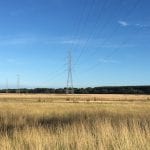Around The Web
Climate change is melting the French Alps, say mountaineers
Permafrost ‘cement’ is evaporating, making rocks unstable and prone to collapse with many trails now deemed too dangerous to use
For the tourists thronging the streets and pavement cafes of Chamonix, the neck-craning view of Mont Blanc, the highest mountain in the Alps, is as dazzling as ever.
But the mountaineers who climb among the snowy peaks know that it is far from business as usual – due to a warming climate, the familiar landscape is rapidly changing.
AGL and Origin: Making a profit didn’t use to be a crime
 Both AGL and Origin are earning more than cost of capital, but so they should be at this point in the cycle.
Both AGL and Origin are earning more than cost of capital, but so they should be at this point in the cycle.
The post AGL and Origin: Making a profit didn’t use to be a crime appeared first on RenewEconomy.
3 lessons to help Australia boost grid reliability & flexibility with storage
 We’re past “trials”: storage is already providing reliability services in around 50 countries - it's time to get on with it.
We’re past “trials”: storage is already providing reliability services in around 50 countries - it's time to get on with it.
The post 3 lessons to help Australia boost grid reliability & flexibility with storage appeared first on RenewEconomy.
How hydrogen power can help us cut emissions, boost exports, and even drive further between refills
Mission Innovation Champions Program - register by 10 September 2018
Vale Malcolm Turnbull: Man who saw the future and feigned to stop it
 Malcolm Turnbull once said Australia had "every resource available ... to meet the challenge of climate change except for one: and that is leadership." We are still waiting.
Malcolm Turnbull once said Australia had "every resource available ... to meet the challenge of climate change except for one: and that is leadership." We are still waiting.
The post Vale Malcolm Turnbull: Man who saw the future and feigned to stop it appeared first on RenewEconomy.
“Scoal-Mo” as PM. What does that mean for climate and energy policy?
 Scott Morrison chosen to lead Liberal Party and to be next prime minister. It's a relief for the renewables industry - compared to a Dutton government- but may be no cause for celebration.
Scott Morrison chosen to lead Liberal Party and to be next prime minister. It's a relief for the renewables industry - compared to a Dutton government- but may be no cause for celebration.
The post “Scoal-Mo” as PM. What does that mean for climate and energy policy? appeared first on RenewEconomy.
E-type Zero: Electric E-type Jaguar going into ‘production’
 After the buzz over recent British royal wedding featuring an EV converted E-type Jaguar, company announces they will offer restored and electrified E-type Jaguars to the public.
After the buzz over recent British royal wedding featuring an EV converted E-type Jaguar, company announces they will offer restored and electrified E-type Jaguars to the public.
The post E-type Zero: Electric E-type Jaguar going into ‘production’ appeared first on RenewEconomy.
The festivals mixing music and science
CP Daily: Thursday August 23, 2018
Lies, damned lies and favourite stats
AGL boss Andrew Vesey steps down immediately
 Andy Vesey, the American at the centre of conservative anger over the decision to close Liddell, has stepped down as CEO of AGL.
Andy Vesey, the American at the centre of conservative anger over the decision to close Liddell, has stepped down as CEO of AGL.
The post AGL boss Andrew Vesey steps down immediately appeared first on RenewEconomy.
NA Markets: WCI prices recover following post-auction sell-off
AEMO cuts predicted uptake of household battery storage by more than half
 AEMO - on advice from the CSIRO - has dramatically reduced its forecast uptake of battery storage by Australian households.
AEMO - on advice from the CSIRO - has dramatically reduced its forecast uptake of battery storage by Australian households.
The post AEMO cuts predicted uptake of household battery storage by more than half appeared first on RenewEconomy.
Kalashnikov takes on Tesla with retro-look electric 'supercar'
Russian arms maker says cutting edge elements will ensure it can take on Elon Musk’s brand
The Russian arms maker Kalashnikov has unveiled its new electric car, inspired by a rare 1970s model, saying the technology will rival Elon Musk’s Tesla.
The brand, best known for the AK-47 machine gun, on Thursday presented the retro-looking pale blue prototype, the CV-1, at a defence expo outside Moscow.
Continue reading...ANALYSIS: Next stop €25? More analysts raise short-term price estimates as EUA rally motors on
Nearly 40,000 giraffe parts have been imported to the US in last 10 years
Researchers from the Humane Society found 52 US locations in which giraffe products continue to be sold
The giraffe population has fallen by around 40% since 1990. There are now fewer than 100,000 giraffes alive in the world, and there are now fewer giraffes than elephants in Africa.
Yet in America, trade in giraffe parts is booming. A report by the Humane Society of the United States, released on Thursday, found that nearly 40,000 giraffe parts have been imported to the US over the past decade, the equivalent, they estimate, of nearly 4,000 individual giraffes.
Continue reading...Ageing fossil fuel plants putting supply at greater risk, says AEMO
 AEMO says ageing coal and gas generators are becoming less reliable and increasing the risk of power outages and load shedding, particularly in Victoria this coming summer. But new wind and solar and storage should reduce risk in future years.
AEMO says ageing coal and gas generators are becoming less reliable and increasing the risk of power outages and load shedding, particularly in Victoria this coming summer. But new wind and solar and storage should reduce risk in future years.
The post Ageing fossil fuel plants putting supply at greater risk, says AEMO appeared first on RenewEconomy.
Ban diesel cars from cities, say half of UK drivers in poll
Almost three-quarters of motorists also think toxic air in their area is damaging their health
More than half of UK motorists think diesel cars should be banned from urban areas due to air pollution concerns, according to a new opinion poll.
The proportion backing a ban rose to 80% when drivers were asked if diesel cars should be excluded areas around schools and hospitals. Nearly a third said diesels should be banned from all roads.
Continue reading...


